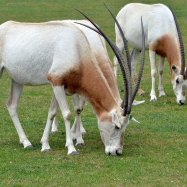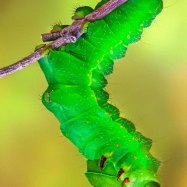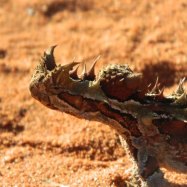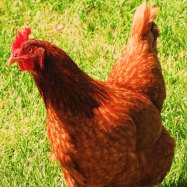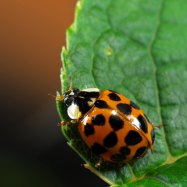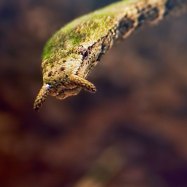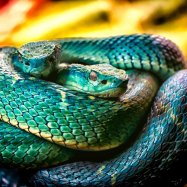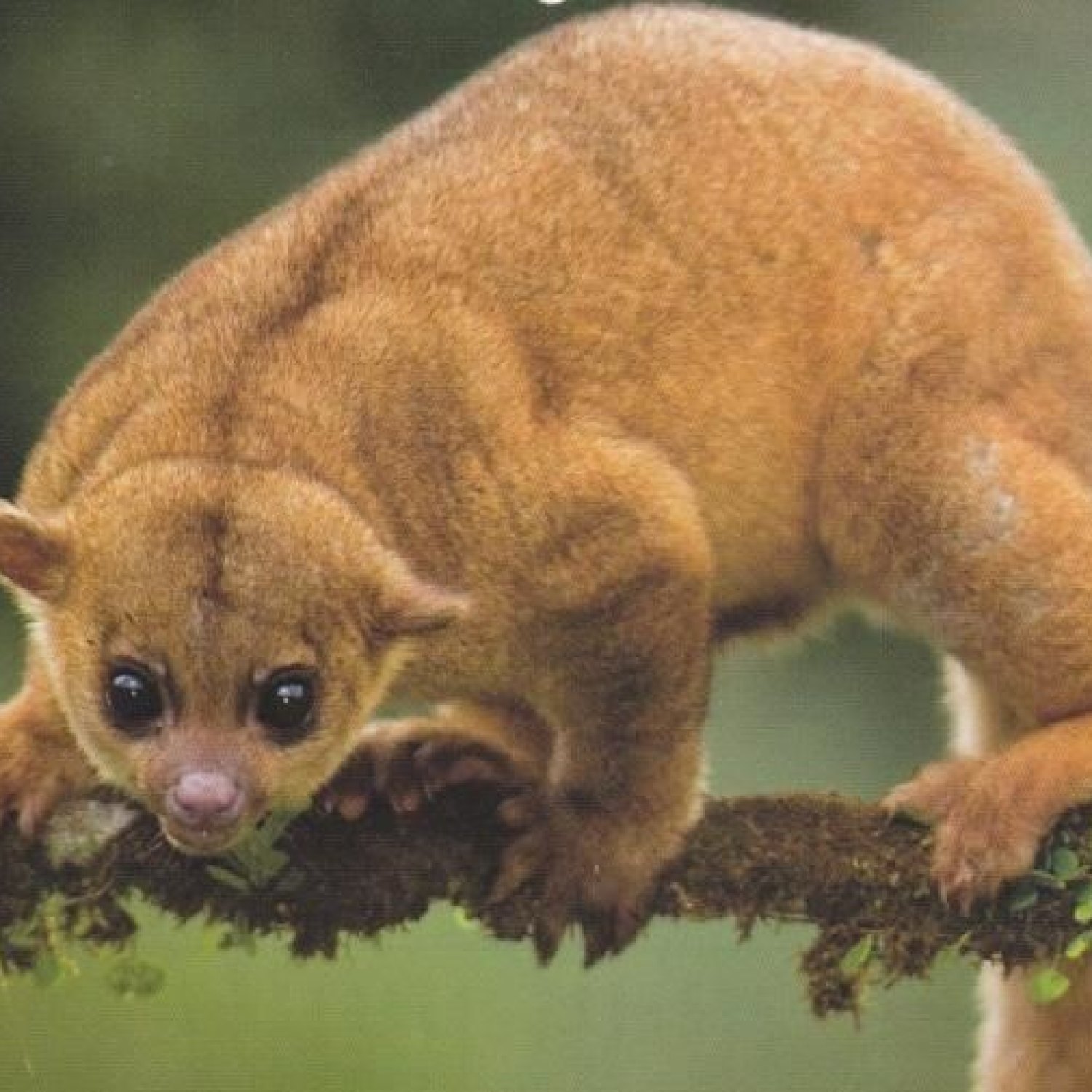
Olingo
35 to 50 centimeters
The olingo, a small mammal of the Procyonidae family, is a master of the treetops. Measuring between 35 to 50 centimeters, this slender and elongated creature can be found dashing through the branches of trees. Have you ever spotted one before? Keep your eyes peeled next time you're in the forest! #olingo #procyonidae #treeclimber #forestdweller #smallmammal
Animal Details Summary:
Common Name: Olingo
Kingdom: Animalia
Habitat: Tropical rainforests
The Olingo: A Fascinating Animal of the Tropical Rainforests
Deep in the lush greenery of the tropical rainforests of Central and South America, lives a little-known animal with an intriguing name – the Olingo. Also known as Bassaricyon in the scientific world, this small mammal belongs to the family Procyonidae, which includes raccoons, coatis, and kinkajous. However, the Olingo stands out with its unique physical characteristics and behavior, making it a fascinating subject for research and discovery. In this article, we will explore the interesting aspects of this lesser-known creature and learn more about its habitat, feeding habits, distribution, and more Olingo.The Classification of the Olingo
Before diving into the specifics of the Olingo, let's first understand its classification in the animal kingdom. The Olingo belongs to the kingdom Animalia, which includes all animals, ranging from tiny insects to majestic elephants. Within this kingdom, the Olingo falls under the phylum Chordata, which comprises animals with a spinal cord. This phylum further divides into classes, and the Olingo belongs to the class Mammalia. Mammals are characterized by their ability to produce milk and their body hair.
The next level of classification is the order, where the Olingo belongs to the carnivorous order Carnivora. However, unlike its other carnivorous counterparts, the Olingo does not solely rely on meat for its diet. We will explore this further in the article. Finally, the Olingo belongs to the family Procyonidae, which includes various other small carnivorous mammals found in the Americas Oilfish.
Habitat and Distribution of the Olingo
The tropical rainforests of Central and South America are the primary habitats of the Olingo. These forests provide the perfect environment for the Olingo to thrive, with an abundance of trees for shelter and various food sources. However, the Olingo is quite adaptable and can also be found in other types of forests, including deciduous and cloud forests.
The distribution of the Olingo is widespread throughout Central and South America, with various countries being home to this fascinating creature. Some of the countries where the Olingo can be commonly found include Costa Rica, Brazil, Colombia, and Peru. However, due to their nocturnal nature, the population of Olingos in these countries is not well studied or known.
Physical Characteristics of the Olingo
The Olingo has a slender, elongated body shape, with an average length of 35 to 50 centimeters (approximately 14 to 20 inches). They are relatively small animals, weighing between 1 to 1.5 kilograms (2.2 to 3.3 pounds), making them about the size of an average house cat. Their fur is soft and dense, ranging from golden-brown to dark brown in color, with their underbelly being a lighter shade.
One of the most distinctive physical features of the Olingo is its long, bushy tail, which can be as long as its body. This tail helps the Olingo balance as it moves between trees and also acts as a communication tool with other Olingos. They have sharp curved claws that allow them to grip onto trees and move with ease.
Feeding Habits of the Olingo
As mentioned earlier, the Olingo is categorized as a carnivorous mammal. However, unlike most carnivores, the Olingo also has an omnivorous diet. Their main food sources include small animals, such as insects, rodents, and birds, along with fruits and nectar from flowers. This diverse diet allows the Olingo to adapt to different environments and ensures their survival even when their primary food source is scarce.
The Olingo is a skilled climber, with its sharp claws and long tail giving it an advantage in the trees. They can move swiftly between branches, and their diet consists mainly of fruits and insects found on high tree canopies. However, when food is scarce, the Olingo will come down to the forest floor to forage for insects and small creatures.
Behavior and Social Structure of the Olingo
The Olingo is a solitary animal, usually active during the night. They have excellent eyesight that helps them navigate through the dark forest, and their keen sense of smell helps them locate their prey. Their agility and agility also make them excellent climbers and gives them an advantage against predators.
As mentioned earlier, the Olingo's long tail plays a crucial role in communication. When threatened, they will use their tail to emit a distinct smell to warn other Olingos in the area. They also use their tail to mark their territory by leaving scent trails.
Threats to the Olingo and Conservation Efforts
Despite their adaptability to different environments, the Olingo's population is at risk due to habitat loss and deforestation. As humans continue to encroach upon their natural habitat, the Olingo is forced to compete with other animals for food and shelter, leading to a decline in their population.
Various conservation efforts are in place to protect the Olingo, including creating protected areas and educating the public about this unique animal. However, more research is needed to fully understand the Olingo's behavior and specific conservation measures that can be taken to ensure their survival.
In Conclusion
In conclusion, the Olingo is a fascinating creature that calls the tropical rainforests of Central and South America its home. From its unique physical characteristics to its omnivorous diet, the Olingo is truly a one-of-a-kind animal. However, their population is at risk due to various human activities, and it is crucial to raise awareness and support conservation efforts to protect these beautiful animals. So, the next time you walk through a tropical rainforest, remember to look up and keep an eye out for the elusive Olingo.

Olingo
Animal Details Olingo - Scientific Name: Bassaricyon
- Category: Animals O
- Scientific Name: Bassaricyon
- Common Name: Olingo
- Kingdom: Animalia
- Phylum: Chordata
- Class: Mammalia
- Order: Carnivora
- Family: Procyonidae
- Habitat: Tropical rainforests
- Feeding Method: Omnivorous
- Geographical Distribution: Central and South America
- Country of Origin: Various countries in Central and South America
- Location: Trees
- Animal Coloration: Golden-brown to dark brown
- Body Shape: Slender and elongated
- Length: 35 to 50 centimeters
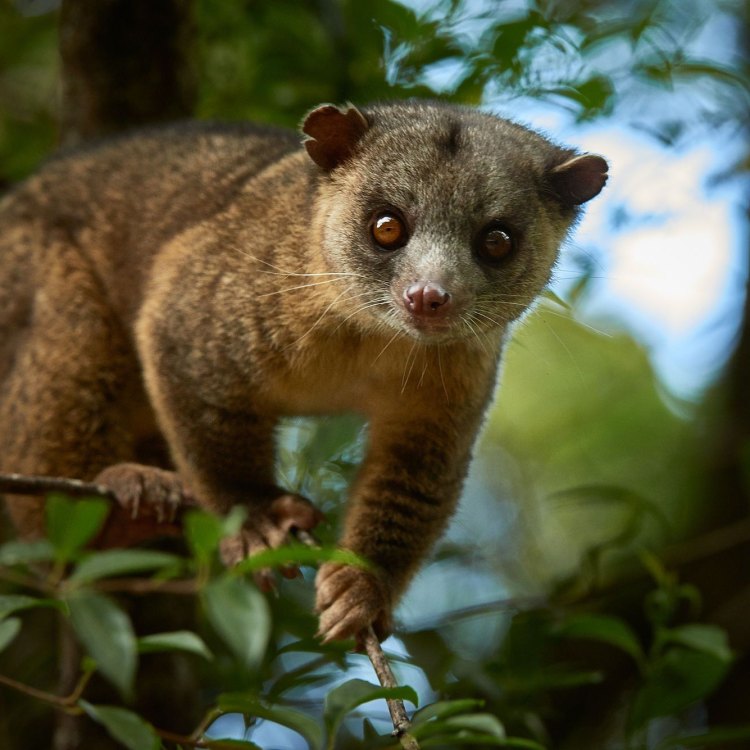
Olingo
- Adult Size: Small to medium-sized
- Average Lifespan: Up to 20 years
- Reproduction: Viviparous
- Reproductive Behavior: Solitary
- Sound or Call: Varied vocalizations
- Migration Pattern: Non-migratory
- Social Groups: Solitary
- Behavior: Nocturnal
- Threats: Habitat loss and fragmentation
- Conservation Status: Least Concern
- Impact on Ecosystem: Seed dispersal
- Human Use: None
- Distinctive Features: Prehensile tail
- Interesting Facts: Olingos are skilled climbers and spend most of their time in trees.
- Predator: Large birds of prey, snakes
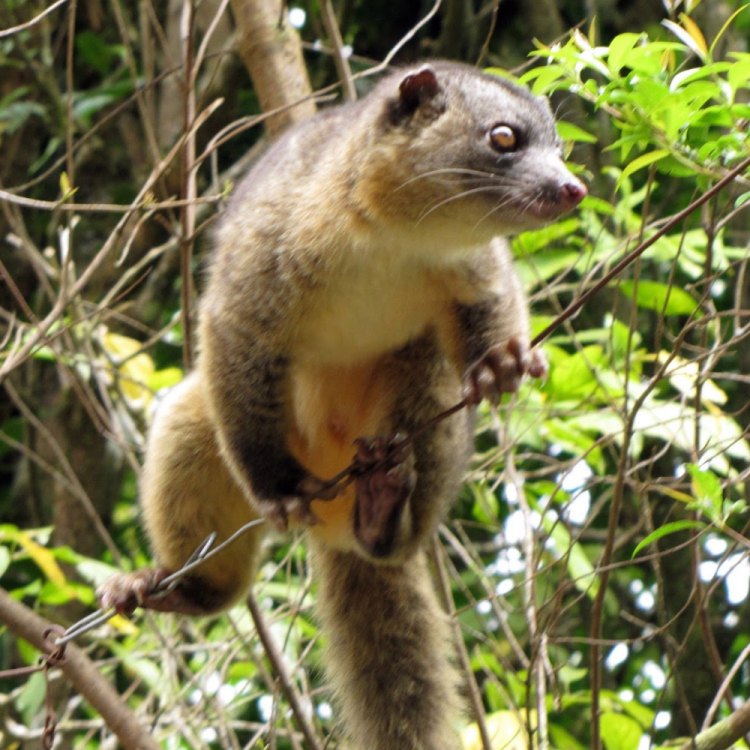
Bassaricyon
The Elusive Olingo: A Hidden Gem in the Rainforest Canopy
Deep in the dense rainforests of Central and South America, a small to medium-sized mammal with a prehensile tail quietly roams the treetops. Its name is Olingo, and despite its elusive nature, it has captured the fascination of scientists and wildlife enthusiasts alike for centuries.While the Olingo may not be as well-known as its cousin, the raccoon, it possesses unique features and behaviors that make it a fascinating creature worth learning about. In this article, we will dive deep into the enchanted world of the Olingo and uncover its secrets PeaceOfAnimals.Com.
The Basics: Size, Lifespan, and Reproduction
The Olingo is a relatively small mammal, measuring around two feet in length and weighing 3-4 pounds as an adult. They have soft, thick fur that ranges from reddish-brown to dark brown, often with a darker mask-like pattern on their face.These solitary creatures have an average lifespan of up to 20 years in captivity. In the wild, however, their lifespan may be shorter due to various factors such as predation and habitat destruction.
One of the most unique aspects of the Olingo's reproductive behavior is that it is viviparous, meaning it gives birth to live young. Unlike many other mammals, the females do not display any obvious changes in behavior or physical appearance during pregnancy. This makes it difficult for scientists to study their reproductive patterns in the wild.
A Solitary Lifestyle and Varied Vocalizations
Olingos are known for their solitary lifestyle, preferring to spend their days and nights alone. They are most active at night, making them nocturnal creatures, and are rarely seen during the day Ocean Pout. This contributes to their elusive nature and makes them difficult to study in the wild.Although solitary, Olingos are not entirely silent creatures. They communicate through a variety of vocalizations, including barks, screams, and chattering noises. These vocalizations can convey different messages, such as warning other animals of danger or marking their territory.
A Non-Migratory Animal with Solitary Social Groups
Unlike many other animals found in the rainforest, the Olingo does not participate in seasonal migrations. They are known to stay within a specific area, and their movements are restricted to the canopy of trees.In addition to being solitary creatures, Olingos also do not form social groups. They may interact with each other during mating or territorial disputes, but otherwise, they prefer to keep to themselves.
Nocturnal Behaviors and Unique Adaptations
As mentioned earlier, Olingos are active at night, with their peak activity occurring during the first hours of the evening. During this time, they use their sharp claws and prehensile tails to navigate through the dense treetops, searching for their favorite foods, such as fruits, insects, and small vertebrates.Their prehensile tails, which can be up to twice the length of their body, are specialized for grasping and hanging in the trees. This unique adaptation allows them to move seamlessly through the branches, even hanging upside down to reach their food.
A Threatened Species: Habitat Loss and Fragmentation
Sadly, the Olingo's elusive nature and nocturnal behaviors have not protected it from the threats brought upon by human activities.The destruction and fragmentation of their natural habitat in pursuit of agricultural and urban development have resulted in a significant decline in Olingo populations. With fewer trees to roam and feed on, these creatures are facing a growing struggle for survival.
Human activities have also caused a decrease in the overall health of the forests, leading to a decrease in food sources for the Olingos. This combination of threats has placed them on the International Union for Conservation of Nature's (IUCN) "Least Concern" list, but their population continues to decline.
The Olingo's Impact on the Ecosystem
Despite the challenges they face, Olingos serve a crucial role in their ecosystem. As they move through the treetops, they help disperse seeds, aiding in the regeneration and growth of the forest.The fruit they consume also plays a vital role in seed dispersal, as the seeds are often spread throughout the forest in the Olingo's droppings. This makes them essential for the natural reproduction and maintenance of the rainforest.
A Species with No Human Use
Many animals are hunted or exploited by humans for various purposes, but the Olingo is not one of them. These creatures have no known economic or cultural value to humans, making them a truly wild and untouched species.Interesting Facts About the Olingo
The Olingo may have a more low-key reputation compared to other well-known animals, but it has some intriguing characteristics and behaviors that are worth noting.For starters, Olingos are excellent climbers and spend most of their time in trees. They are also known to have a unique defensive tactic, where they will secrete a foul-smelling substance from glands near their anus when threatened. This liquid is said to be potent enough to ward off predators.
However, some predators may pose a real threat to Olingos in the wild. Large birds of prey, such as eagles and hawks, are known to attack them, as well as some species of snakes.
A Creature Worthy of Protection and Conservation
With its distinctive features, unique behaviors, and crucial role in the ecosystem, the Olingo is undoubtedly a species worthy of protection and conservation efforts. Organizations such as the IUCN and The Rainforest Trust are working towards preserving their natural habitat and promoting awareness about the importance of this elusive creature.As humans continue to expand their impact on the planet, it is crucial to recognize the role of each species, no matter how small, in maintaining the balance of our ecosystem. With efforts in place to protect the Olingo, we can ensure that this hidden gem of the rainforest continues to thrive for generations to come.
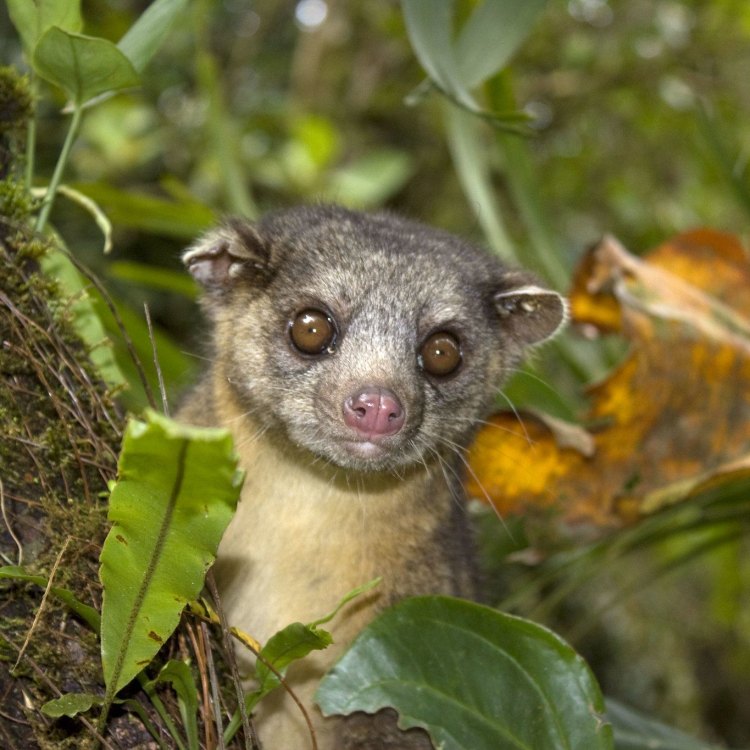
The Olingo: A Fascinating Animal of the Tropical Rainforests
Disclaimer: The content provided is for informational purposes only. We cannot guarantee the accuracy of the information on this page 100%. All information provided here may change without prior notice.

